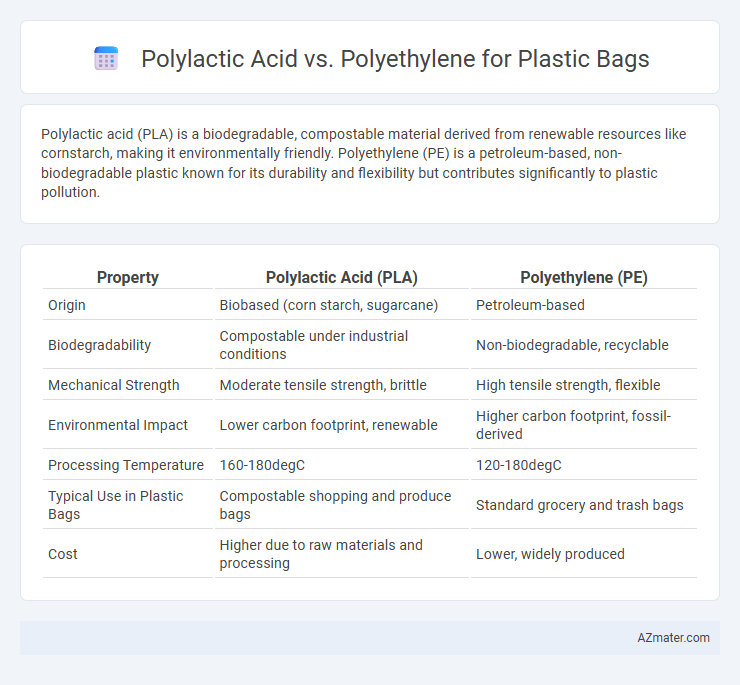Polylactic acid (PLA) is a biodegradable, compostable material derived from renewable resources like cornstarch, making it environmentally friendly. Polyethylene (PE) is a petroleum-based, non-biodegradable plastic known for its durability and flexibility but contributes significantly to plastic pollution.
Table of Comparison
| Property | Polylactic Acid (PLA) | Polyethylene (PE) |
|---|---|---|
| Origin | Biobased (corn starch, sugarcane) | Petroleum-based |
| Biodegradability | Compostable under industrial conditions | Non-biodegradable, recyclable |
| Mechanical Strength | Moderate tensile strength, brittle | High tensile strength, flexible |
| Environmental Impact | Lower carbon footprint, renewable | Higher carbon footprint, fossil-derived |
| Processing Temperature | 160-180degC | 120-180degC |
| Typical Use in Plastic Bags | Compostable shopping and produce bags | Standard grocery and trash bags |
| Cost | Higher due to raw materials and processing | Lower, widely produced |
Introduction to Polylactic Acid and Polyethylene
Polylactic acid (PLA) is a biodegradable, bio-based polymer derived from renewable resources like corn starch or sugarcane, making it an eco-friendly alternative to traditional plastics. Polyethylene (PE), a widely used synthetic polymer, is produced from petrochemical feedstocks and known for its durability and flexibility in plastic bag applications. The comparison between PLA and PE centers on environmental impact, biodegradability, and mechanical properties relevant to plastic bag performance.
Chemical Structure and Composition Comparison
Polylactic acid (PLA) is a biodegradable aliphatic polyester derived from renewable resources like corn starch, composed of repeating lactic acid units with ester linkages that promote hydrolysis. Polyethylene (PE) is a synthetic polymer made from ethylene monomers, featuring a simple hydrocarbon chain structure with strong carbon-carbon bonds that confer high durability and resistance to degradation. PLA's chemical structure allows for compostability and environmental breakdown, while PE's hydrocarbon backbone provides superior strength but contributes to long-term persistence in ecosystems.
Production Processes and Raw Materials
Polylactic acid (PLA) is produced from renewable resources like corn starch or sugarcane through fermentation and polymerization processes, making it biodegradable and environmentally friendly. Polyethylene (PE), derived from petroleum or natural gas via polymerization of ethylene monomers, involves energy-intensive refining and cracking steps. PLA production emphasizes sustainable raw materials and lower carbon footprint, while PE relies on non-renewable fossil fuels with more complex chemical processing.
Biodegradability and Environmental Impact
Polylactic acid (PLA) offers superior biodegradability compared to polyethylene (PE), as PLA is derived from renewable resources like corn starch and decomposes under industrial composting conditions within months. In contrast, PE, a petroleum-based plastic, can persist in the environment for hundreds of years, contributing significantly to plastic pollution and microplastic formation. The environmental impact of PLA is generally lower due to its reduced carbon footprint and biodegradability, making it a more sustainable alternative for plastic bags in terms of waste management and resource use.
Mechanical and Physical Properties
Polylactic acid (PLA) exhibits higher stiffness and tensile strength but lower impact resistance compared to polyethylene (PE), making PLA more brittle and less flexible for plastic bag applications. PE offers superior elongation at break and excellent toughness, providing greater durability and tear resistance under mechanical stress. Physically, PLA is biodegradable and has a lower melting point around 150-160degC, while PE is non-biodegradable with a melting range of 105-130degC for LDPE and 125-135degC for HDPE, impacting processing and environmental considerations.
Cost and Economic Considerations
Polylactic acid (PLA) plastic bags generally have a higher production cost compared to polyethylene (PE) bags due to the expense of renewable raw materials like corn starch and more complex manufacturing processes. Economically, PE bags benefit from well-established, large-scale production facilities and cheaper fossil fuel-based feedstocks, making them more cost-effective for mass-market distribution. However, PLA bags may offer long-term economic advantages through potential regulatory incentives and growing consumer demand for sustainable alternatives despite their current higher unit price.
Performance in Plastic Bag Applications
Polylactic acid (PLA) offers superior biodegradability and a lower carbon footprint compared to traditional polyethylene (PE), making it an eco-friendly choice for plastic bag applications. However, polyethylene excels in strength, flexibility, and moisture resistance, ensuring better durability and longer shelf life for plastic bags in various storage and transportation settings. PLA bags tend to degrade faster under composting conditions but may lack the robustness and stretchability found in high-density polyethylene (HDPE) bags commonly used in retail.
Legislative and Regulatory Perspectives
Polylactic acid (PLA) is increasingly favored in legislative frameworks promoting sustainable alternatives due to its biodegradability and compatibility with composting standards, contrasting with polyethylene's reliance on fossil fuels and persistence in the environment. Regulatory bodies in the European Union and parts of North America have introduced bans or restrictions on single-use polyethylene bags, incentivizing shifts towards PLA through subsidies and eco-labeling requirements. Compliance with international standards such as ASTM D6400 and EN 13432 for PLA ensures market access and aligns with circular economy goals, whereas polyethylene faces stricter disposal and recycling mandates to mitigate pollution.
Consumer Perception and Market Trends
Polylactic acid (PLA) is increasingly favored by environmentally conscious consumers for plastic bags due to its biodegradability and renewable resource origins, contrasting with traditional polyethylene which is derived from non-renewable fossil fuels and associated with environmental pollution. Market trends show a growing demand for PLA bags in regions with strict plastic regulations and eco-friendly product initiatives, while polyethylene continues to dominate due to its cost-effectiveness and durability. Consumer perception highlights PLA as a premium, sustainable alternative, though concerns about composting infrastructure and performance in wet conditions affect widespread adoption compared to polyethylene.
Future Outlook and Innovations
Polylactic acid (PLA) offers a promising future outlook as an eco-friendly alternative to polyethylene (PE) in plastic bag production due to its biodegradability and renewable bio-based origins. Innovations in PLA include enhanced mechanical properties and accelerated composting technologies, addressing traditional limitations like brittleness and slow degradation. Conversely, polyethylene remains dominant for durability and cost-efficiency, but ongoing research aims to integrate recycled content and improve recyclability to mitigate environmental impact.

Infographic: Polylactic acid vs Polyethylene for Plastic bag
 azmater.com
azmater.com